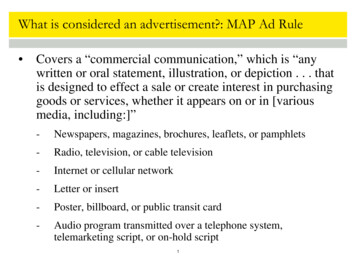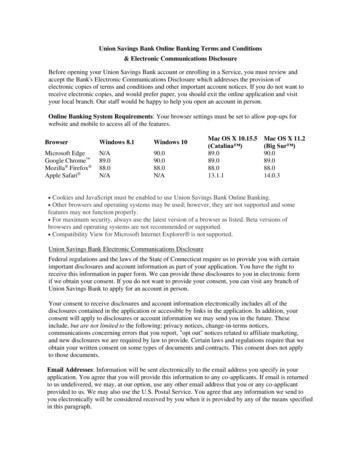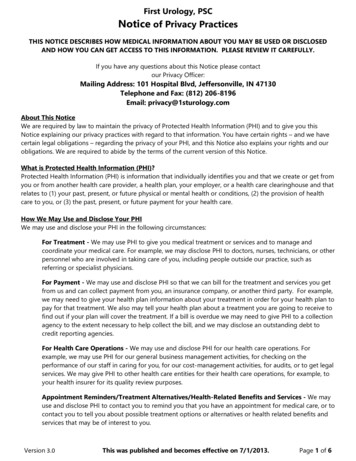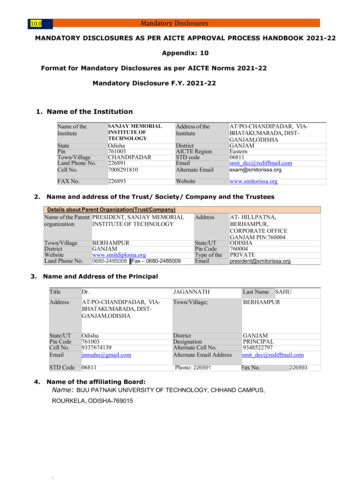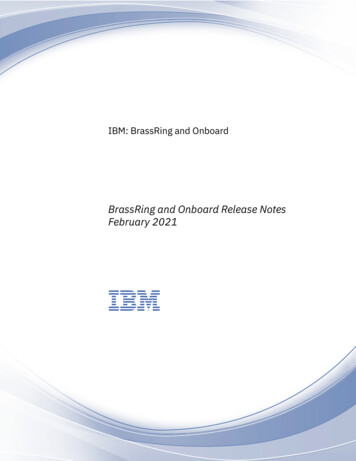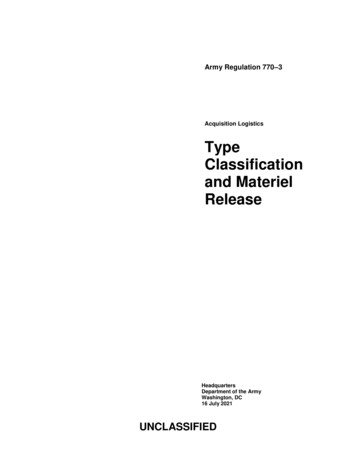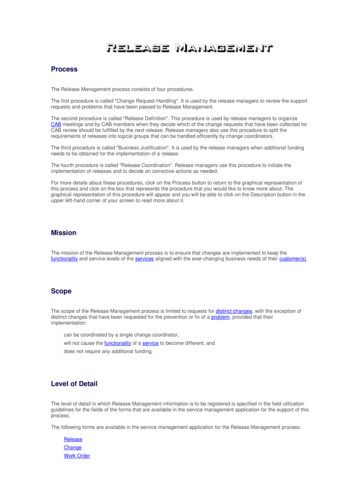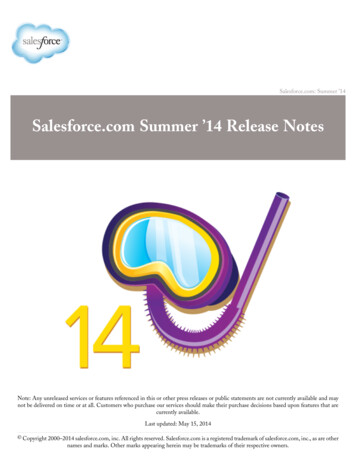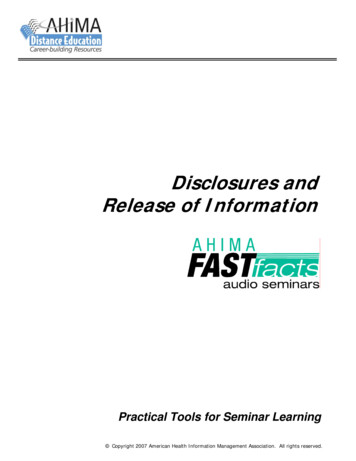
Transcription
Disclosures andRelease of InformationPractical Tools for Seminar Learning Copyright 2007 American Health Information Management Association. All rights reserved.
DisclaimerThe American Health Information Management Association makes norepresentation or guarantee with respect to the contents herein and specificallydisclaims any implied guarantee of suitability for any specific purpose. AHIMA hasno liability or responsibility to any person or entity with respect to any loss ordamage caused by the use of this audio seminar, including but not limited to anyloss of revenue, interruption of service, loss of business, or indirect damagesresulting from the use of this program. AHIMA makes no guarantee that the useof this program will prevent differences of opinion or disputes with Medicare orother third party payers as to the amount that will be paid to providers of service.How to earn one (1) CEU for participationTo earn one (1) continuing education unit, each participant must do the following:Step 1:Listen to the seminar, via Webcast link, audio CD, or MP3.Step 2:Complete the assessment quiz contained in this resource book.Use the included answer key. Do not return the quiz to AHIMA.Save it for your records.Step 3:EACH LISTENER must ces.html and completethe sign-in form and the seminar evaluation.Step 4:After you complete the evaluation, you will receive your CE certificate whichyou should print for your records. The certificate must be retained by eachparticipant as a record of their participation, along with a copy of their completedquiz.i
FacultyNanette B. Sayles, EdD, RHIA, CCS, CHP, FAHIMANanette Sayles has extensive health information management in hospitals, a computervendor and a consulting company. She was the 2005 Triumph Educator award winner.She has held numerous offices and other volunteer roles for the American HealthInformation Management Association, the Georgia Health Information ManagementAssociation, the Alabama Association of Health Information Management, MiddleGeorgia Health Information Management Association and Birmingham Regional HealthInformation Management Association.Dr. Sayles has published two books: Professional Review Guide for the CHP, CHS, andCHPS Examinations and Case Studies in Health Information Management. She iscurrently the Program Director of the Health Information Management and TechnologyPrograms/Associate Professor at Macon State College in Macon, Georgia.Dr. Sayles has a BS in Medical Record Administration, a MS in Health InformationManagement, a Masters in Public Administration, and a doctorate in Adult Education.ii
Table of ContentsDisclaimer . iHow to earn one (1) CEU for participation . iFaculty .iiDiscussion Topics . 1Federal Laws . 1Reasons for Disclosure and Release of Information Include. 2State Laws . 2Use vs. Disclosure . 3Authorization vs. Consent . 3Who can consent to release of information? . 4Who can consent when patient can't? . 4Authorization to Release Information . 5Valid Authorization . 5-6Revoke Authorization. 6Authorization Required . 7Authorization Not Required . 7-8Methods of Release . 8Faxing Requests. 9Patient Access. 9Denying Access.10Individuals do not have right to .11Subpoena .11Valid Subpoena – General Requirements .12Court Order .12Valid Court Order – General Requirements .13Redisclosure .13Accounting of Disclosure.14-16Minimum Necessary .16Resource/Reference List .17-19AHIMA Audio Seminars .19About assessment quiz .20Thank you for attending (with link for evaluation survey) .20Appendix.21Articles (Journal of AHIMA):HIPAA on the Job: Release of Information under HIPAA (Journal of AHIMA)Release of Information: The BasicsSample Forms:ABC Medical Center Return of Invalid Authorization for Release of InformationSample Health Record Correction/Amendment FormAssessment QuizCE Certificate and Sign-in InstructionsQuiz Answer Key
Disclosures and Release of InformationNotes/CommentsDiscussion Topics Discuss the privacy laws and regulations, bothfederal and state specific, governing the disclosureof health information Review best practices in responding to release ofinformation requests Discuss how to manage HIPAA’s patient access1Federal LawsHealth Insurance Portability and Accountability Actof 1996 Clinical Laboratory Improvement Act of 1988 Privacy Act of 1974 USA Patriot Act Freedom of Information Act Drug Abuse Prevention, Treatment, andRehabilitation Act of 1972 21
Disclosures and Release of InformationNotes/CommentsReasons for Disclosure and Release ofInformation includePatient care Legal process Life insurance Medical insurance Accident settlement Quality of care Risk management 3State Laws State laws vary from state to state Good resources are state hospital association ormedical association42
Disclosures and Release of InformationNotes/CommentsUse vs. Disclosure Disclosure Use5Authorization vs. Consent Authorization: patient authorizes release ofprotected health information that has alreadybeen created Consent: patient authorizes release of protectedhealth information that has not been created63
Disclosures and Release of InformationNotes/CommentsWho can consent to release information?Competent legal adult Legal guardian or parent of minor Executor Emancipated minor MarriedSelf-supporting and does not live with parentsPregnantMilitary16 and living independently7Who can consent when patient can’t? Varies by state, but typically Legal guardianSpouseAdult childParentAdult brother or sisterDocumentation to support claim of legalguardian required84
Disclosures and Release of InformationNotes/CommentsAuthorization to release information Authorization must be in writing Fax or copies OK if policy allows Emergent release Call back processDocumentationGet release after the fact9Valid AuthorizationDescription of information to be released Name of person who is requesting release Name of org/person to release information Purpose of request Expiration date Statement regarding patient’s right torevoke/exceptions to right to revoke Potential for redisclosure Signature of individual and date 105
Disclosures and Release of InformationNotes/CommentsValid Authorization Authorization is invalid if: Expiration date has passedNot completely filled inAuthorization has been revoked in writingRequired elements are missingFacility knows that information provided is false11Revoke authorization Patient has right to revoke Must request revocation in writing Can’t revoke what has already been sent126
Disclosures and Release of InformationNotes/CommentsAuthorization Required Psychiatric information/psychotherapynotes Marketing Insurance Law enforcement Patient13Authorization not required Treatment, Payment, Healthcare Operations (TPO) Accreditation and licensure Courts Employers: worker’s compensation Funeral home: limited147
Disclosures and Release of InformationNotes/CommentsAuthorization Not Required Health Departments Medical Examiner Research Institutional Review Board approvalAs required by law15Methods of Release Mail Picked up Fax Electronic168
Disclosures and Release of InformationNotes/CommentsFaxing requests Allowed under HIPAA Decide based on state laws and needs of yourorganization Check pre-programmed numbers Attach confidentiality statement Place in secure areas17Patient AccessRight to review and/or copy Should make appointment Get request for access in writing Facility has 30 days to comply for onsite recordsand 60 days to comply for off site records Someone should sit with patient Only physician can interpret clinical contents ofrecord Can charge reasonable fee for making copies orsummary report 189
Disclosures and Release of InformationNotes/CommentsDenying AccessPatient cannot challenge if:Patient is inmate PHI collected through research and the patientpreviously agreed to limitation on access whichis still in place. Government record Obtained under promise of confidentiality 19Denying AccessNotify patient of reason Patient can challenge if Patient endangered if he or sees record Someone referred to in record may be harmed Personal representative makes request and you believe thatrequest may harm patient or someone else. Another professional must review ifchallenged. That decision is binding.2010
Disclosures and Release of InformationNotes/CommentsIndividuals do not have right to: Psychotherapy notes Information compiled in reasonable anticipationof, or for use in, civil, criminal, or administrationor action or proceeding PHI when CLIA prohibits21Subpoena Command by court or other authorized official Subpoena ad testificandum Subpoena duces tecum Satisfactory assurance2211
Disclosures and Release of InformationNotes/CommentsValid Subpoena – General RequirementsJurisdiction Name of court Names of the parties involved Docket (case) number Date, time and place Documents to be produced (when appropriate) Signature, stamp, seal of official Witness fees, where allowed 23Court Order Court authorizes what would be prohibited bystatute2412
Disclosures and Release of InformationNotes/CommentsValid Court Order – General RequirementsName of court Names of parties involved Limitations of content Limitations of who content is disclosed to Other limitations Signature of judge 25Redisclosure Records from other hospitals Part of permanent record2613
Disclosures and Release of InformationNotes/CommentsAccounting of DisclosureDo not require tracking Treatment, Payment, Healthcare OperationsIndividual (patient or according to authorization signedby patient)National security or intelligenceCorrectional institutions orLaw enforcement, if requestedPrior to date of HIPAA implementation27Accounting of Disclosure Disclosures by practice Disclosure by business associate2814
Disclosures and Release of InformationNotes/CommentsAccounting of Disclosure What must be maintained? Date of disclosureName and address of entity receiving PHI, if knownBrief description of PHIStatement of why releasedIf multiple disclosures to same, then first everything,after that frequency and date of last event29Accounting of Disclosure Health Oversight agency or lawenforcement – temporary suspension Account of disclosure information must beretained for 6 years 60 days turnaround 1-30 day extension possibleNotify patient of delay3015
Disclosures and Release of InformationNotes/CommentsAccounting of Disclosure First request is provide free Any additional requests in 12 month periodreasonable fee Facility must provide opportunity to withdrawbefore charging31Minimum NecessaryHIPAA covered entity Release only the minimum necessary forpurpose Does not apply to: Disclosures for patient careDisclosures to patientDisclosures per patient authorizationDisclosure required to meet HIPAA transactionsDisclosure to DHHS for enforcementDisclosures required by law3216
Disclosures and Release of InformationNotes/CommentsResource/Reference List LaTour, K.M. and S. Eichenwald-Maki (2006). Health InformationManagement: concepts, Principles, and Practice. American HealthInformation Management Association: Chicago, ?pc AB103306&bURL %2Forders%2FSearchAction%2Ecfm%3F Johns, M. L. (2006). Health Information Management Technology:An Applied Approach. American Health Information ManagementAssociation: Chicago, ?pc AB103106&bURL nce List Roach, Jr., W. H., Hoban R.G. and B.M. Broccolo et al. (2007) MedicalRecords and the Law. American Health Information ManagementAssociation and Jones and Bartlett Publishers: Chicago, IL andBoston, MA.3417
Disclosures and Release of InformationNotes/CommentsResource/Reference List Practice Brief: Release of Information Reimbursement Lawsand Regulations blic/documents/ahima/bok1 023132.hcsp?dDocName bok1 023132 HIPAA on the Job: Release of Information under HIPAA Release of Information: The Basics ABC Medical Center Return of Invalid Authorization forRelease of secure/documents/ahima/bok1 009470.hcsp?dDocName bok1 009470 (Note: this article is available to AHIMA members only, through the FORE Library Body s/secure/documents/ahima/bok1 009547.hcsp?dDocName bok1 009547 (Note: this article is available to AHIMA members only, through the FORE Library Body s/secure/documents/ahima/bok1 027652.pdf (Note: this articleis available to AHIMA members only, through the FORE Library Body of Knowledge.)35Resource/Reference List Laws and Regulations Governing the Disclosure of HealthInformation blic/documents/ahima/bok1 016464.hcsp?dDocName bok1 016464 Sample Health Record Correction/Amendment Form Practice Brief: Patient Access and Amendment to e/documents/ahima/bok1 016258.hcsp?dDocName bok1 016258 (Note: this article is available to AHIMA members only, through the FORE Library Body ofKnowledge.)Records blic/documents/ahima/bok1 000027.hcsp?dDocName bok1 000027 Redisclosure of Patient Health Information blic/documents/ahima/bok1 018169.hcsp?dDocName bok1 0181693618
Disclosures and Release of InformationNotes/CommentsResource/Reference List Practice Brief: Understanding the Minimum Necessary roups/public/documents/ahima/bok1 018177.hcsp?dDocName bok1 018177 Preemption Analysis Under HIPAA—Proceed with Caution by /documents/ahima/bok3 005197.hcsp?dDocName bok3 00519737AHIMA Audio SeminarsVisit our Web sitehttp://campus.AHIMA.orgfor updated information on thecurrent seminar schedule.While online, you can also register forlive seminars or order CDs andWebcasts of past seminars. 2007 American Health Information Management Association19
Disclosures and Release of InformationNotes/CommentsAssessmentTo access the assessment quiz that follows thisseminar, download the seminar’s resource book .htmlYour sign-in form and certificate of completion are also foundin the resource book.Thank you for attending!Please visit the AHIMA Audio SeminarsWeb site to complete your evaluationform online s.html20
AppendixArticles (Journal of AHIMA):HIPAA on the Job: Release of Information under HIPAA (Journal of e/documents/ahima/bok1 009470.hcspRelease of Information: The e/documents/ahima/bok1 009547.hcspSample Forms:ABC Medical Center Return of Invalid Authorization for Release of secure/documents/ahima/bok1 027652.pdfSample Health Record Correction/Amendment documents/ahima/bok1 016258.hcspAssessment QuizCE Certificate and Sign-in InstructionsQuiz Answer Key
HIPAA on the Job: Release of Information under HIPAAby Margret Amatayakul, RHIA, FHIMSS, and Kathleen A. Frawley, JD, MS, RHIAWith tighter rules and greater penalties, many hospitals are reassessing their disclosurepractices, release of information functions, and copy service contracts. What are the issues tobe concerned about?What Rules Apply?The entire set of privacy standards relates to the appropriate use and disclosure of protectedhealth information. These include issues of:zzzzzzzconsentauthorizationopportunity to agree or objectminimum necessaryde-identificationright to request restrictionsright to an accounting for disclosuresAll have important new considerations.Who's Responsible?Traditionally, the burden of obtaining consent would fall first on admissions personnel.Many hospitals are concerned that obtaining consent at this point will slow down the processof admissions, which they are trying to speed up. Admissions personnel may also not haveadequate background to respond to questions concerning the clinical implications of some ofthe individuals' rights.For reasons both related to work flow as well as obtaining informed consent for treatment,some hospitals have started to make significant changes in the admissions area—essentiallyeliminating patient contact with admissions. Many admissions functions related toinformation collection, insurance coverage, financial counseling, and preadmissions testingare performed before the patient arrives at the hospital. In other cases, thepatient is a directadmit from the emergency department, also bypassing admissions.What formerly were admissions functions have been taken over by "front end" businessoffice personnel. It has, therefore, become the responsibility of nursing to ensure thatappropriate consents exist once the patient arrives at ure/documents/ahima/bok1 009470.hcsp?dDocName bok1 009470
One area that remains unclear is the matter of patient-requested restrictions. Although mosthospitals are able to admit patients anonymously (as "confidential," "a.k.a.", or VIP patients),this has traditionally been an all-or-nothing process. And, sometimes, it has not worked wellbetween the clinical and financial systems.Under HIPAA, the patient may request a restriction that is much more granular than in thepast. For example, the patient may request that a specific nurse or lab technician not haveaccess to information. While hospitals do not have to accept such restrictions, some hospitalswill look to their system vendors for further support for this function. This will also requiregreater input from clinicians who can evaluate the impact of restrictions on patient care.Authorization and Accounting for Uses and DisclosuresBecause of the privacy rule's specificity with respect to when an authorization is required andwhen it is not required, many hospitals are cracking down on areas that release information—other than the HIM department. Where in the past radiology may have released a copy of"just the last x-ray report," everyone is becoming much more cognizant of privacyrequirements.Nursing areas are refusing to speak to callers concerning the status of patients, requestingthem to contact the patient or his or her personal representative directly. And organizationsare beginning to recognize that when an individual presents to an ancillary area, the identityof the individual requesting information must be verified.All members of the healthcare team are more aware of rules associated with what may andmay not be released. They are also more aware of the need to obtain an authorization shoulda patient later request an accounting of use and disclosure. Many patient care areas thatformerly were fairly lax about releasing information have come to realize the associatedissues and are directing such requestors routinely to the HIM department.Minimum Necessary and De-IdentificationThe final privacy rule requires that organizations limit the personal health informationdisclosed to the "minimum necessary to accomplish the intended purpose of the use,disclosure, or request." The rule also specifies how health information can be shared withoutan authorization when it has been properly "de-identified." Determining what the "minimumnecessary" is and when to de-identify information requires special expertise. In particular, thejury may still be out on how to determine the minimum necessary.HIM departments have traditionally been good at gatekeeping for these functions. However,minimum necessary and de-identification require renewed attention in all areas. For example,an HIM department that provides copies of records to a physician for a non-IRB approvedresearch study with patient's name and medical record number removed may not trulyremove all identifying information.The "minimum necessary" standard applies to other areas as well. Some accounting systemsdump all accounts receivable files into a collections file, although not all accounts qualify forcollections. Further, some of these files contain far more information than is minimallynecessary for collections agencies. Many hospitals refuse participation in any surveysrequesting patient-identifiable information. However, not all hospitals follow this cure/documents/ahima/bok1 009470.hcsp?dDocName bok1 009470
To respond to such surveys, hospitals will need to negotiate business associate contracts withsuch requestors or fully de-identify the data according to HIPAA requirements.How Is Release of Information Affected?In addition to hospital-wide issues of use and disclosure, the release of information functionis specifically coming under increased scrutiny. Many HIM professionals are reassessingtheir organization's quality of work in this area. Whether outsourced or not, any informationreleased erroneously—always a cause for concern—is now not only an unfortunate incidentbut could result in penalties for noncompliance with HIPAA.How Can I Assess Our Release of Information Function?Traditionally, HIM departments have relied on recipients of incorrect information to reporterrors in release of information. Under HIPAA, a more proactive stance needs to be taken.There are several activities that can be considered.Start with policies and procedures:zzzzzHave policies and procedures for release of information been updated with HIPAArequirements?Do policies and procedures for release of information also reflect more stringent staterequirements?Are policies and procedures for release of information circulated to all applicableareas (for example, nursing, admissions/registration)?Do all personnel in the facility know how to obtain copies of policies and procedureson release of information?Do policies and procedures reflect revision dates to ensure changes are made whenthere are changes in rules?Review the authorization form and process. Does the authorization form:zzzzzzzzzrequest sufficient identifying information to be able to positively select the correctpatient's medical record for copying? (If the hospital's population has a lot ofcommon names, more information than simply the name and address of patient shouldbe obtained.)contain checkboxes for the patient to check off what specific information, by type anddate, is to be released to meet the minimum necessary requirement?ask for the name or class of person to whom the information is to be released?contain an expiration date or event that relates to the individual or purpose of the useand disclosure? (This will require obtaining the purpose of the request.)contain a statement that information used or disclosed may be subject to redisclosureby the recipient and no longer be protected by the privacy rule?contain a checkbox to indicate the identity of the requestor has been verified and how(for example, by reviewing a photo identification or matching a signature)?are patients given a copy of the authorization form?are staff thoroughly trained in this process? (If "checks and balances" are needed, thiscould be part of the overall QI function.)include, if the authorization is for the hospital to request information for its own usesor disclosures or for others, statements as ocuments/ahima/bok1 009470.hcsp?dDocName bok1 009470
- purpose of use or disclosure?- that the individual has the right to inspect or copy the information to be used ordisclosed?- that the individual has the right to refuse to sign the authorization?- whether there is any direct or indirect remuneration associated with the use ordisclosure?Audit the copying function:zzzzzzIs there a system to review at least a sample of all information copied before it isreleased on a regular basis, and if outsourced, that this audit is shared with theprovider?Does the audit process check the copied material against the name and otheridentifying information as well as the requested content on the authorization form?Does the audit process include verification that any material relating to amendmentfrom the patient (including a request for amendment that has been denied) that relatesto the requested content to be released is also released?Does the audit process check that a copy of the authorization has been filed in thechart?Are records of the audit kept in order to provide personnel counseling and to increasethe size of the sample as necessary?Is there a way to trend results and, if necessary, prove oversight of the process?Audit for releases made without authorization:zzzzIs there documentation of any release of information made for other than treatment,payment, or operations that does not require an authorization?Do release of information personnel know when an authorization is required and whenan authorization is not required?Is release of information occurring elsewhere in the facility? (Consider using anexternal audit service to test this.)Are records of the audit kept in order to provide personnel counseling and to increasethe size of the sample as necessary?Track complaints:zzzzIs there a log of callers or other correspondence to the release of information deskconcerning any indications that information was:- not received?- received erroneously?- not received in a timely manner?Is there a facility-wide information privacy incident reporting mechanism from whichrelease of information complaints can also be identified?Is every incident on the log investigated? (Does the HIM department have the authorityto investigate and remediate release of information incidents outside the department?If not, who does? Is there coordination between this individual and the HIMdepartment?)Are records of the investigations kept in order to provide personnel roups/secure/documents/ahima/bok1 009470.hcsp?dDocName bok1 009470
zzzzzzDo all personnel in the HIM department receive training on handling requests forrelease of information (if only to refer them to designated personnel)?Are other personnel from key areas periodically provided training on release ofinformation (if only to refer them to designated personnel in the HIM department)?Is a log kept of all release of information training, including who attended and whattraining was provided?Is training accompanied by a certification process?Do release of information contract service personnel obtain training from the
Disclosures and Release of Information 5 Notes/Comments Authorization to release information Authorization must be in writing Fax or copies OK if policy allows Emergent release Call back process Documentation Get release after the fact 9 Valid Authorization Description of information to be released Name of person who is requesting release
